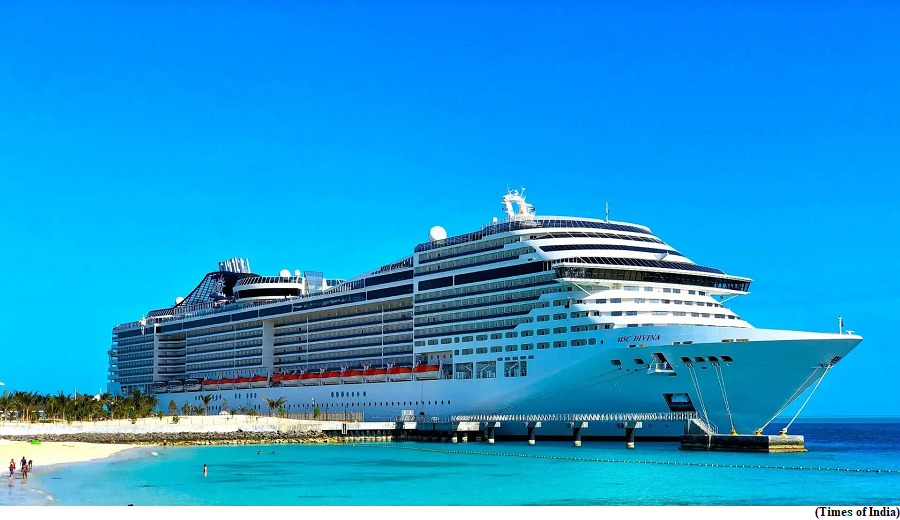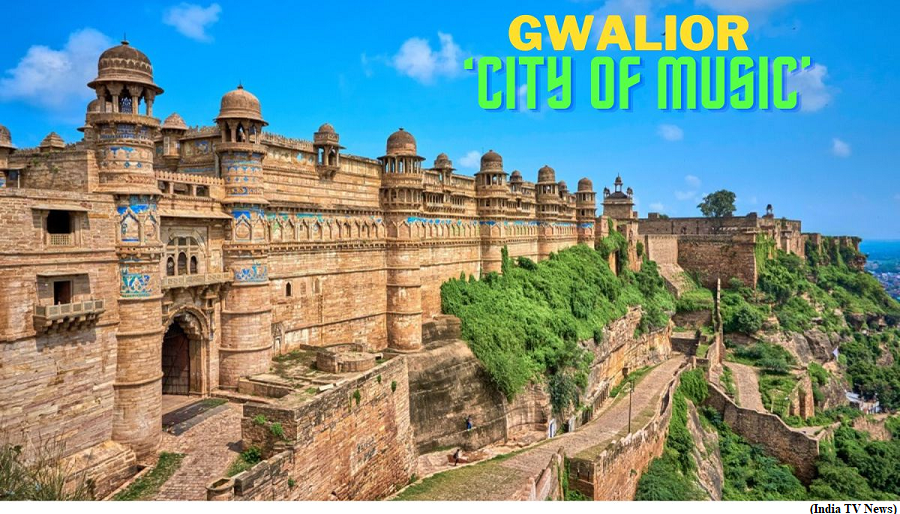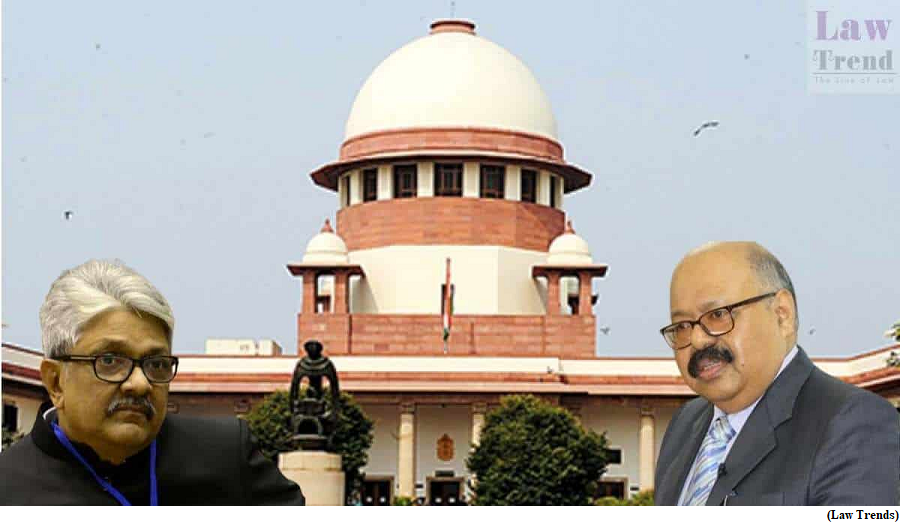Domestic sailing of the first International Cruise Liner in India (GS Paper 3, Economy)

Why in news?
- Recently, the Union Minister of Ports, Shipping & Waterways flagged off the maiden voyage of the vessel Costa Serena, the first International Cruise Liner in India from Mumbai.
Cruise sector:
- India has enhanced its focus on the cruise sector with Ministry of Ports, Shipping and Waterways (MoPSW) actively promoting cruise tourism for its vast economic positive impact, the potential for job creation, for earning foreign exchange, amongst many other benefits.
- One of the key thrust areas is to develop cruise destinations at tourism places of coastal state and islands.
Costa Cruises:
- The launch of Costa Cruises' domestic sailings has been made possible by a series of initiatives taken by the government to promote and revitalize the cruise tourism industry in India.
- Costa cruises, Italy is part of Carnival Corporation, one of the largest cruising conglomerates in the world with reputed cruise brands.
- These measures include guaranteed berths to cruise ships, removal of Ousting charges, Concessional uniform single rate for all Major ports, Volume discounts in cruise tariff up to 30% for domestic cruise ships, waiver of cabotage for foreign cruise vessels, Uniform SOPs for Customs, Immigrations, CISF, Ports, upgradation and modernization of cruise terminals with enhance passenger facilities, etc.
Initiatives for River cruise tourism in India:
- One of the most significant steps in this journey taken recently was the conditional IGST exemption to foreign flag foreign going vessel when it converts to coastal run, which substantially reduced the financial burden on foreign cruise operators.
- As a result of these initiatives, from 102 Cruise ship Calls and 84,000 Passengers handled in 2013-14, the tally went up to 227 calls and 4.72 lakh passengers during 2022-23 representing an increase of 223% in cruise calls and 461% in cruise passengers in the last 9 years.
- River cruise tourism has also seen a 180% rise in operations during the last 9 years.
Sagarmala Programme:
- Development of cruise tourism and lighthouse tourism are being actively considered under MoPSW's flagship scheme Sagarmala Programme.
- For promoting tourism in maritime states under Sagarmala, projects have been identified in convergence with Ministry of Tourism and tourism development departments of maritime state governments.
- Over a period of the last 9 years Sagarmala Programme has completed 11 Projects worth Rs.267 crores promoting coastal & cruise tourism and Island Development.
- Some of these projects include Cruise Passenger Facilitation Centre at Chennai, Construction of International Cruise Terminal at Cochin and development of Cruise Berthing and Cruise Passenger facilities at Mormugao Port.
Maritime India Vision 2030:
- Under the Maritime India Vision 2030, Government envisions to establish India as the premier cruise hub in the Asia Pacific region.
- To achieve this goal, significant steps are being taken, including the development of state-of-the-art cruise terminals, the implementation of standardized procedures, and the introduction of e-visa facilities, among other measures. Going forward, the objective is to increase the annual number of cruise passengers in India to 18 lakhs by 2030, up from the current figure of 4.72 lakhs.
Maritime Amritkaal Vision 2047:
- In accordance with the Maritime Amritkaal Vision 2047 launched by the Prime Minister during the recently concluded Global Maritime India Summit 2023 in Mumbai, it is projected that India will have 25 operational cruise terminals by 2047, with an estimated annual passenger count of approximately 5 million cruise passengers per year.
- Government is also planning to launch a well-defined and consistent cruise tourism policy in line with international standards and practices.
- This policy will encompass various critical aspects such as GST, taxation, excise, and custom duties, both at the central and state levels, with the aim of fostering the growth of this emerging industry within India.
UNESCO declares Gwalior the ‘city of music’
(GS Paper 1, Culture)
Why in news?
- The city of Gwalior in Madhya Pradesh was added to UNESCO’s Creative Cities Network (UCCN) recently for its “strong commitment to harnessing culture and creativity”.
- Kozikodhe from Kerala was also among the 55 new cities to join the network.

Gwalior gharana:
- Gwalior gharana, the oldest musical gharana and a significant chapter of Hindustani classical music’s history flourished under the aegis of Raja Man Singh Tomar during the 15th century.
- Man Singh’s great grandfather Dungarendra Singh Tomar, a musician himself, attempted a revival of Indian classical music through academic interest and patronage. He is known to have gifted two music treatises in Sanskrit – Sangeet Shiromani and Sangeet Choodamani – to his friend and Sultan of Kashmir Zain-ul-Abdin. The treatises comprised detailed discussions on music and musical instruments.
- Dungarendra also composed Vishnupadas (songs in praise of Vishnu) with a unique style of singing that he passed down to Man Singh, who ascended the throne in 1486. It’s also believed that Man Singh invented dhrupad, in a classical genre sense. His Horis and Dhamars also became quite popular.
- The king would take advice from Sufi saints, who were often musicians too. In an attempt to popularise Indian music, he replaced Sanskrit songs with those in simple Hindi.
- Man Singh also wrote Manakutuhala (Quest for Learning), considered the first treatise of music in Hindi, helping a wider audience to understand high art performed in kings’ courts. This made dhrupad more accessible, which now comprised Vishnupadas sung in ragas.
- The king also built huge music halls in his palace and held regular music sessions. His music was also popular among Sufis as well as Muslim Sultans.
Characteristics of the Gwalior gharana:
- Before Hindustani classical music was divided into various gharanas, musical ideologies and systems where the musicians identify with a style either by lineage or by learning and following this style, Gwalior emerged as the first proper gharana of music and evolved under the Mughal rule.
- The initial ustads of the gharana included Naththan Khan, Naththan Pir Baksh and his grandsons Haddu, Hassu, and Natthu Khan.
- Khayal singing emerged from dhrupad under the aegis of Gwalior gharana while incorporating the elements of qawwali.
- Ustad Naththan Pir Baksh was one of the early masters to create khayal, the orderly system of presenting a raga which became extremely popular in the 18th and 19th centuries and remains significant even today.
- One interesting about Gwalior is the inclusion of Persian words in the pieces and concepts of bandish ki thumri (a more structured style of thumri or love song).
- Every artist who emerged from Gwalior gharana sounded different and yet there was a certain unity in the style.
Mian Tansen:
- Mian Tansen born as Ramatanu to a poet and musician was one of Gwalior’s early proteges. At the beginning of the 16th century, he trained under Swami Haridas, who practised dhrupad but the poetry was dedicated to Krishna instead of Vishnu.
- The famed Sufi saint Mohommad Ghous also had a huge impact on Tansen. While learning from Ghous, Tansen understood and honed the Gwalior gharana style and was the court musician for King Ram Chandra Singh of Rewa, Madhya Pradesh, for many years.
- The story of his musical brilliance and knowledge travelled and Akbar invited Tansen to be a part of his court musicians in the Mughal court. A Vaishnava musician, he first refused, but after Ram Chandra insisted he go, he joined the court at the age of 60.
- Abul Fazl’s Ain-i-Akbari mentions 36 imperial musicians, out of which 15 were from Gwalior. Akbar’s admiration for Tansen has found much place in popular culture and much of it comes from the writings about the musician.
Some notable names from the Gwalior gharana:
- The well-known names include Haddu Khan’s son Bade Inayat Hussain Khan (1852-1922), Vasudeva Buwa Joshi, Balakrishnabuwa Ichalkaranjikar (1849–1926) who taught Vishnu Digambar Paluskar who later founded the Gandharva Mahavidyalaya which continues till today, famed educator BR Deodhar and Pakistani singer Farida Khanum among others.
- The generation that came after included Pt Kumar Gandharv, Malini Rajurkar, Veena Sahasrabuddhe, and Dharwad-based Pt Venkatesh Kumar, whose music also has distinct touches of Kirana gayaki among others.
Advocate on Record system in the Supreme Court
(GS Paper 2, Judiciary)
Why in news?
- The Supreme Court recently pulled up an Advocate-on-Record (AoR) for filing a frivolous case and dismissed the public interest litigation. The Court censured the lawyer that an AoR cannot merely be a “signing authority.”
- A bench of Justices also called for a “comprehensive plan” for reforming and improving the AoR system of the top court, which will be drawn up in collaboration with the Bar.

Who is an AoR?
- Only an AoR can file cases before the Supreme Court. An AoR might engage other lawyers including senior counsels to argue before the Court but the AoR is essentially the link between the litigant and the highest court of the country.
- After fulfilling an eligibility criteria and clearing a rather tough examination, an advocate is qualified to be an AoR.
- AORs are a pool of elite Delhi-based lawyers whose legal practice is mostly before the SC. They can appear before other courts too. The idea behind this practice is that a lawyer with special qualifications, picked by the Supreme Court itself, is equipped to appear for a litigant because it is a court of the last opportunity for the litigant.
How does one become an AoR?
- The Supreme Court Rules, 2013 prescribe eligibility criteria for an AoR.
- While an advocate has to clear an examination set by the Court itself, the advocate has to meet specific criteria to be eligible to appear for the exam. The advocate must train with a court approved AoR for at least one year to take up the exam. She must also have at least four years of practice before starting the training itself.
- An advocate needs to score at least 60% i.e. a minimum of 240 marks out of 400 with at least 50% in each subject in a three-hour exam. The subjects include Practice and Procedure, Drafting, Professional Ethics and Leading Cases. Approximately 200-250 lawyers clear the exam to become AoRs.
- An AoR must have an office in Delhi within a 16-kilometre radius of the SC. Additionally, she is required to give an undertaking to employ, within one month of being registered as an AoR, a registered clerk.
What are the rules governing the AoR system?
- According to Section 30 of the Advocates Act, any lawyer enrolled with the Bar Council is entitled to practice law before any Court or tribunal in the country. However, the provision also categorically states that “nothing in the provision shall be deemed to affect the power of the Supreme Court to make rules under Article 145 of the Constitution.”
- Under Article 145 of the Constitution, the Supreme Court is empowered to make rules and regulate its own procedure for hearing cases.
- The AoR system is broadly based on the British practice of barristers and solicitors. While barristers wear the black gown and wig and argue cases, solicitors take up cases from clients.
- In the Federal Court, the colonial predecessor of the Supreme Court, “agents” would take up cases while barristers would argue.
- In High Courts, the arguing counsels were referred to as pleaders. Senior advocates in India are designated by the Court and wear a distinct gown. Like barristers, they cannot solicit clients and are only briefed by other lawyers, say for example, an AoR.
- The inaugural proceedings of the SC was done after “taking care to ensure that the Rules of the Supreme Court were published and the names of all the Advocates and agents of the Federal Court were brought on the rolls of the Supreme Court.”




